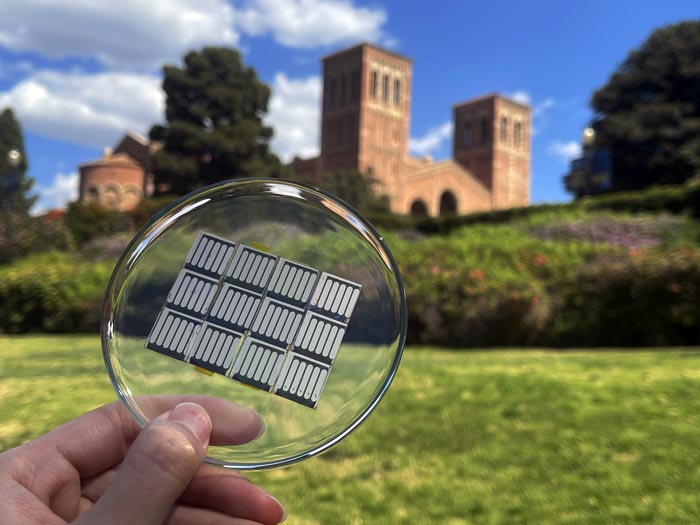Solutions to biggest hurdle for solar cell technology

Photo of a thin film perovskite solar cell produced with a manufacturing process fix developed by UCLA researchers and colleagues.
Credit: Shaun Tan/UCLA
Fix in a manufacturing step of perovskite solar cells paves the way for commercialization of the high-performance, sunlight-to-electricity discovery.
Materials scientists at the UCLA Samueli School of Engineering and colleagues from five other universities around the world have discovered the major reason why perovskite solar cells — which show great promise for improved energy-conversion efficiency — degrade in sunlight, causing their performance to suffer over time. The team successfully demonstrated a simple manufacturing adjustment to fix the cause of the degradation, clearing the biggest hurdle toward the widespread adoption of the thin-film solar cell technology.
A research paper detailing the findings was published today in Nature as an early access paper. The research is led by Yang Yang, a UCLA Samueli professor of materials science and engineering and holder of the Carol and Lawrence E. Tannas, Jr., Endowed Chair. The co-first authors are Shaun Tan and Tianyi Huang, both recent UCLA Samueli Ph.D. graduates whom Yang advised.
Perovskites are a group of materials that have the same atomic arrangement or crystal structure as the mineral calcium titanium oxide. A subgroup of perovskites, metal halide perovskites, are of great research interest because of their promising application for energy-efficient, thin-film solar cells.
Perovskite-based solar cells could be manufactured at much lower costs than their silicon-based counterparts, making solar energy technologies more accessible if the commonly known degradation under long exposure to illumination can be properly addressed.
“Perovskite-based solar cells tend to deteriorate in sunlight much faster than their silicon counterparts, so their effectiveness in converting sunlight to electricity drops over the long term,” said Yang, who is also a member of the California NanoSystems Institute at UCLA. “However, our research shows why this happens and provides a simple fix. This represents a major breakthrough in bringing perovskite technology to commercialization and widespread adoption.”
A common surface treatment used to remove solar cell defects involves depositing a layer of organic ions that makes the surface too negatively charged. The UCLA-led team found that while the treatment is intended to improve energy-conversion efficiency during the fabrication process of perovskite solar cells, it also unintentionally creates a more electron-rich surface — a potential trap for energy-carrying electrons.
This condition destabilizes the orderly arrangement of atoms, and over time, the perovskite solar cells become increasingly less efficient, ultimately making them unattractive for commercialization.
Armed with this new discovery, the researchers found a way to address the cells’ long-term degradation by pairing the positively charged ions with negatively charged ones for surface treatments. The switch enables the surface to be more electron-neutral and stable, while preserving the integrity of the defect-prevention surface treatments.
The team tested the endurance of their solar cells in a lab under accelerated aging conditions and 24/7 illumination designed to mimic sunlight. The cells managed to retain 87% of their original sunlight-to-electricity conversion performance for more than 2,000 hours. For comparison, solar cells manufactured without the fix dropped to 65% of their original performance after testing over the same time and conditions.
“Our perovskite solar cells are among the most stable in efficiency reported to date,” Tan said. “At the same time, we’ve also laid new foundational knowledge, on which the community can further develop and refine our versatile technique to design even more stable perovskite solar cells.”
The other corresponding authors on the paper are Rui Wang, an assistant professor of engineering at Westlake University in Hangzhou, China; and Jin-Wook Lee, an assistant professor of engineering at Sungkyunkwan University in Suwon, South Korea. Both Wang and Lee are previous UCLA postdoctoral researchers advised by Yang.
Researchers from UC Irvine; Marmara University, Turkey; and National Yang Ming Chiao Tung University, Taiwan, also contributed to the paper.
The research was supported by the U.S. Department of Energy’s Office of Energy Efficiency and Renewable Energy.
Journal: Nature
DOI: 10.1038/s41586-022-04604-5
Method of Research: Experimental study
Subject of Research: Not applicable
Article Title: Stability-limiting heterointerfaces of perovskite photovoltaics
Article Publication Date: 15-Mar-2022
Media Contact
Christine Wei-li Lee
University of California, Los Angeles
clee@seas.ucla.edu
Office: (310) 206-0540
All latest news from the category: Materials Sciences
Materials management deals with the research, development, manufacturing and processing of raw and industrial materials. Key aspects here are biological and medical issues, which play an increasingly important role in this field.
innovations-report offers in-depth articles related to the development and application of materials and the structure and properties of new materials.
Newest articles

Innovative 3D printed scaffolds offer new hope for bone healing
Researchers at the Institute for Bioengineering of Catalonia have developed novel 3D printed PLA-CaP scaffolds that promote blood vessel formation, ensuring better healing and regeneration of bone tissue. Bone is…

The surprising role of gut infection in Alzheimer’s disease
ASU- and Banner Alzheimer’s Institute-led study implicates link between a common virus and the disease, which travels from the gut to the brain and may be a target for antiviral…

Molecular gardening: New enzymes discovered for protein modification pruning
How deubiquitinases USP53 and USP54 cleave long polyubiquitin chains and how the former is linked to liver disease in children. Deubiquitinases (DUBs) are enzymes used by cells to trim protein…



